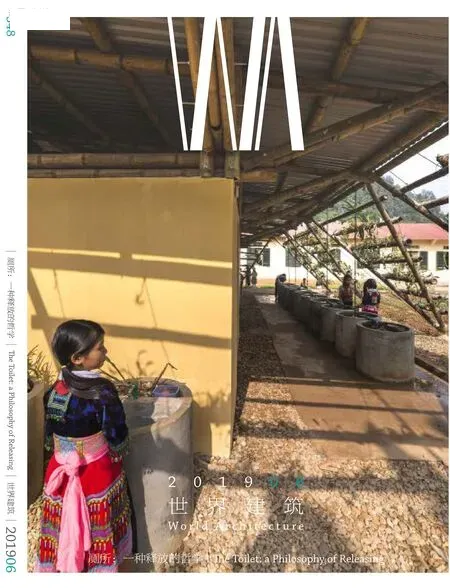厕所:一种释放的哲学
2019-02-13张利ZHANGLi
张利/ZHANG Li
我们的生命依赖于新陈代谢的周而复始,而其中的很大一部分是我们释放身体的废物。可以说,我们对周遭世界的一项重要输出就是我们的排泄。当然,从传统观点的角度看,排泄通常是无奈的、毫无浪漫可言的,且其产出品也实在是普遍不受欢迎的。
同时,在不少传统文明中,并不是所有的生存必需都要有相应的文化呈现。实际上,在人类文明史的大多数阶段,我们选择尽可能地隐藏我们对废物的释放。建筑虽然在人类历史上自始至终以丰富的语汇表现了人类的生活,但当关涉我们用于排泄的空间时,其面貌往往乏善可陈,卑微地隐匿在某个角落。
这一状况直到最近才得到转变。文明进步的基本特征是知识的创造与积累,特别是我们对自己的了解——我们不仅越来越了解自身的“美”,也越来越了解自身的“丑”——或者更准确地说,越来越了解我们自身的美与丑的可互换性。幸运的是,我们现在生活在一个思想开明的时代。幸运的是,我们正在把用于排泄的空间——厕所——的物质形态作为一个严肃的设计话题来研究。
好的设计理念总是建立在大胆的哲学质询之上的。当谈及厕所这一释放废物的空间理念时,其哲学质询是从一个看似困难的问题开始的:如果厕所的清洁、高效和用户友好归根到底仍然是实用目的,那么它的艺术目的是什么,假如有的话?
一旦建筑师开始试图为厕所赋予意义,回答这个问题就不那么困难了。实际上,将厕所视为纯粹的工程学对象实在是老生常谈,会束缚建筑师的手脚,无法给出有力的设计解答。现在陈词滥调大多已渐消散,厕所也正日益成为一个建筑学对象。在这方面,我们大致从三个方向看到了令人振奋的答案。
第一个方向是环境,即减少人类作为一个物种的生态足迹,闭合宏观的生物圈循环:我们的排泄是且必须是地球上自然物质大循环的一个节点。大的环保理念模糊了伦理和美学之间的界限,创造了以环境关怀抵达艺术境界的机会,这使厕所很快就成为了能够承载这种大理念的灵活有力的载体。越南H&P建筑事务所设计的两个“绿厕所”(厕所+洗漱+植被)使用了被动式建筑技术,并全部用乡土建筑语言表达。类似的方式也出现在丹麦TYIN设计室建筑事务所在泰国设计的港湾浴室和原本营造工作室的枣园旱厕中,使用当地可再生建筑材料、独立于任何基础设施管网进行废物处理及独特的——如果不是经过深思熟虑的话——田园化的外观,都是亚洲乡村地区这类“新”厕所的特征。
第二个方向是人体。历史上,我们在排泄的身体姿态运用方面无比灵活,当客观条件充满局限时甚至会展现出惊人的想象力。以内在的生理需求为先导,因地制宜,确实有可能将厕所当成一种综合、多使用维度的家具。多磨建社在中国设计的放牛场村小学卫生站以脑海中青少年的身体塑造了它的空间。身体空间、色彩和空间功能都根据当地儿童的生理和心理量身打造。中国UAO瑞拓设计的澴河环厕残存着20世纪中国老式公厕的记忆,在那些地方,人体之间曾因缺乏隐私反而创造了意想不到的集体主义感。同样的集体主义被演绎到排泄单元的排列中,与所有必要的现代隐私规则无缝结合。印度罗汉·恰范的“休憩室”则展现了极度的乐观主义精神,还将幽默感注入到了厕所的概念之中。它不折不扣地将释放的身体空间延伸至自新的身体空间。虽然将排泄、小憩和理发等活动相互联系在一起可能对一些人来说不太好接受,但无论如何,这都是建筑值得尝试去做的。
第三个方向是诗意。通过回避所有与排泄有关的棘手联系,将公厕空间视同于任何其他类型的建筑,赋予建筑师在厕所中进行空间诗意创作的合法性。如果拒斥死亡的负面意义可以像欧内斯特·贝克尔所说的那样,为艺术创造了良好开端,那么拒斥排泄的负面属性则肯定是对厕所进行任意的自由的艺术解读的良好开端。不出意外的是,在这里我们的例证来自于日本和挪威。岛田阳的弧墙小屋完全搁置公厕的功能线索,而是将它组织成一个自主线索的空间构成。基于理性的屋顶系统与自由曲线墙体系统之间的矛盾作用,其在空间逻辑上的对话远远超出了诠释排泄行为的范畴。MORFEUS建筑设计事务所的布刻克耶卡休息站是挪威一贯的自然建筑思想的产物。混凝土表面的连续角折叠提供了几何景框和行人步道,而唯一封闭的空间——厕所被镜子包裹,最大程度地消解了自己。在这里,我们已经习惯甚至感到乏味的挪威公式——一点可视化的人工干预(几何景框)加一点非可视化的人工干预(封闭的如厕空间)加一片无处不在的原生本色(自然环境)等于与自然亲合的建筑——再次显示了它的有效性。□
Our lives are at the mercy of the cycles of our metabolism, a big chunk of which is the discharging of waste from our bodies. It is fair to say that a significant of our output to the world around us is through releasing ourselves. Though by some traditional wisdom, the releasing process is usually helplessly unromantic, and its product universally undesirable.
Also by some traditional wisdom, not everything necessary needs to be explicitly represented. For the greater part of human civilisation, we chose to hide our releasing as much as possible. While architecture throughout history has been a rich expressing human lives, spaces for our releasing have been consistently dull and anonymous.
Only until recently. It is true that we civilise not only by knowing more about our own beauty,but also by knowing more about our own ugliness.Or to be more precise, knowing more about the interchangeability of our beauty and ugliness.Fortunately we now live in a time of open-mindedness.Fortunately we are taking the physical shaping of our releasing spaces, toilets, as a serious design topic.
Good design ideas are always built upon daring philosophical investigations. When it comes to the idea about toilets, the philosophical investigation starts with a seemingly difficult question: with all its cleanness, efficiency, and user-friendliness being still nothing more than practical purposes, what is the artistic purpose of a toilet, if any?
As soon as an architect sets off to bring meaning into toilets, the question becomes no longer difficult.Actually it was the cliché of regarding a toilet as a pure engineering subject that disabled architects from giving a solid answer to the question. Now that cliché is mostly gone and we are witnessing promising answers generally from three perspectives.
The first perspective is the environment. The reduction of the ecological foot print of our entire species, the completion of the great circle of live:our waste is and can only be a natural phase along the gigantic material cycle on the planet. With big environmental ideas blurring the line between ethics and aesthetics, toilets quickly become small vehicles capable of carrying such big ideas. The two Toigetation (toilet + washing + vegetation)projects by the Vietnamese ffiice H&P Architects experiments passive building technologies and vernacular architectural language in full, almost redundantly. Similar approach is found in TYIN's Safe Haven Bathhouse in Thailand, and Original Architect's Latrine in Jujube Orchard in China.The use of local renewable building material, the independence from any infrastructure grid for waste treatment, and the distinctive, if not deliberate,rural look are all features that define such "new"toilets in the Asian countryside.
The second perspective is the human body. In history we have been incredibly flexible in our body positions of releasing. Sometime even imaginative when the available condition is limited and the intrinsic urge is paramount. There is indeed an possibility of designing toilets as large, multi-faceted furniture. DOMAT's Hygiene Station for Cattlefield Village School in China shapes its space with the bodies of the youthful in mind. The body spaces,colours, and spatial programmes are all tailored to the physiology and psychology of the local children.UAO's Round Toilet in China plays with memories of old Chinese public toilets of the last century where the lack of privacy between the releasing bodies created unexpected collectivism. A rendition of that same collectivism in releasing with all necessary modern privacy provisions is accomplished. Rohan Chavan's Pause in India puts extreme optimism and adds sense of humour to the toilet concept. It unapologetically extends the body space of releasing to those of refreshing. The inter-connection between the bodily activities of releasing, napping and hair cutting might be a challenge to some. But it is a worthy architectural attempt anyway.
The third perspective is poetics. Through the denial of all tricky associations with releasing,architects legitimate themselves in the creation of poetics in public toilets spaces, as much as they do in any other kind of buildings. If the denial of death makes a good start for making art, as Ernest Becker put it, the denial of excretion can certainly be a good beginning for any free artistic interpretation of a toilet. We have projects from, unsurprisingly,Japan and Norway as proofs. Yo Shimada's Hut with the Arc Wall suspends the public toilet programme,composes an autonomous spatial object out of it.The contradiction between the rational roof system and the free curve wall system presents a dialogue in spatial logic far beyond the necessity of releasing.MORFEUS' Bukkekjerka is a recent incarnation of the consistent Norwegian architectural thinking of nature. The continuous angular folding of concrete surfaces provides geometric landscape frames and pedestrian paths, while the only enclosed volume,the toilets wrapped in mirrors, dematerialises itself to a maximum degree. The coherent (almost boringly so) Norwegian formula of something (open frame),nothing (enclosed space) and everything (nature)ends up in soothing poetics yet for another time.□
